|
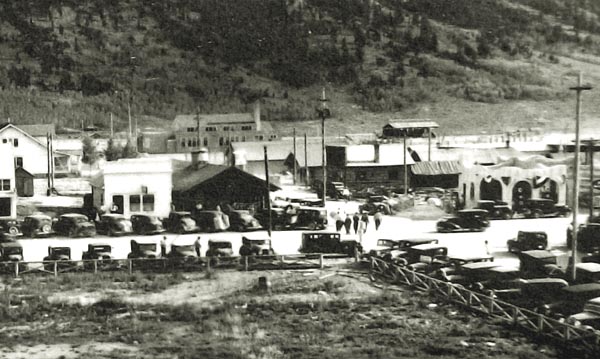
Intersection of Broadway and Cache as viewed from across the Sqaure, Jackson, approx. 1934
The bare area on the southwest corner of the Square marks the former site of the Odd Fellows hall which was removed in 1934.
The gas station at the right in the picture on the southwest corner of Cache and Broadway was part of the Wort Garage operated prior to his death in
1933 by Charles Wort. Worth previously operated a livery stable on the present site of the Wort Hotel. Visible across the roof top toward the upper right side of the
photo is the grandstand for the rodeo grounds. As previously mentioned, the rodeo grounds moved from its location south of Broadway to its present location in the
early 1930's.
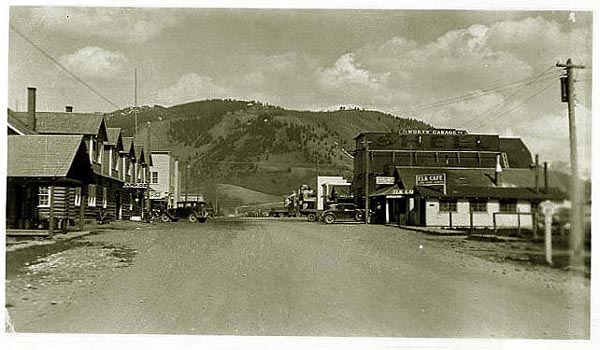
Looking east along Broadway toward Cache, approximately 1930.
Cache is the intersection immediately past the automobiles. The two-story building on the left immediately past the intersection is the
Odd Fellows lodge then located at the northeast corner of the intersection and actually within what would later be
dedicated as the Town Square. On the right is Wort's Garage.
As later discussed, the major changes in Jackson came during the post-war years. The most significant changes have been to
the intersection of Broadway and Cache. The changes that have overcome Jackson have been critized. Amy Kiessling in the nomination
of the Van vleck house to the National Register
noted the "frenzied drive to create 'a wild west image' that represents the communities [sic] role as a tourist town but not its early history."
See nomination p 9. Indeed, even the
New York Times has weighed in on the changes to Jackson. A story in The New York Times in reporting a collision between a
pickup truck and a polo pony began:
A pickup truck hit a polo pony here last week.The Truck won that skirmish between the Old West and the faux West. But in the
wider cultural collision here, the Old West is beating a retreat over Teton Pass to Idaho or down the Salt River to a
quiet town called Freedom.Brook James S: "Tourists Win Cultural Shootout in Jackson, Wyo.", New York Times, August 14, 1998.
The Southeast corner of the Square for a long time beginning in June 1957 was the centerpiece of Ms Kiessling's "frenzied drive" give a wild west image to the Jackson.
There on early summer evenings there would be a wild west shootout between a desperado named
Clover the Killer and a posse. Even though Jackson Hole had a reputation at the turn of the century as the lair of many outlaws and rustlers, the valley was quite peaceful.
It was occupied by Mormons and outlaws each adopting a
"live and let live" attitude toward one another. In the valley other than the shootout at the Bar Flying U near Moose discussed with regard
to the Grand Tetons, a murder suicide near Wilson in 2013, the murder of two
girls by a transient psychopath in a local hotel in 1964, and the occasional body found alongside the road, the Valley and Jackson have been
remarkably quiescent -- no bank robberies, the stages into and out of the valley were not held up. To "give 'em what they want," a small group began an evening shootout at corner of
Cache and Broadway. The script was pretty much ad hoc involving the shootout between a posse and
Clover Sturlin, a.k.a. "Clover the Killer." Clover would at times ride his horse into Paul Hanson's store. the only part of the story enacted by the group that was true was that there
really was a Clover Sturlin (1900-1979). Indeed, Sturlin played himself and is credited by some as having originated
the idea of a shootout to hold tourists in town in the evening. Sturlin rode into town about 1929 and, among other things,
acted as a rodeo clown for the rodeo.
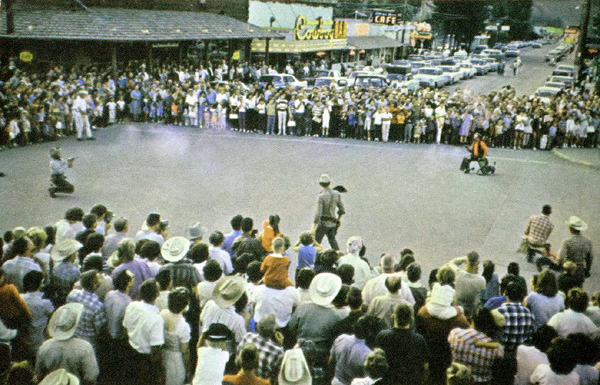
Shootout late 1950's, northwest corner of Cache and Broadway.
To provide background music for the shootout, Eddie Ashcraft (1927-2003, stage name Eddit Pardee)
wrote lyrics for a song, sung to the tune of "little Old Log Cabin in the Lane." The same tune has been used in a number of
songs including "Little Joe the Wrangler," "Beans, Bacon and Gravy," "The Double-Breasted Mansion on the Hill," "The Little Red Caboose Behind the Train," "the
Hobo Tramp," "The Wreck of the Old 97" "The Ship That Never Returned," and the Kingston Trio's "the Song of the MTA." In 2004, the song was sung by then Governor Mitt Romney when a new
fare system was instituted on the Boston subway system. The new system precluded poor Charley from having to spend the rest of his life beneath the streets of
Boston as "the Man Who Never Returned. The song protested the adoption of a fare increase by the MTA which made passengers pay an
additional fee to get off. Poor Charley did not have the additional fare and was thus doomed to ride the MTA beneath the
streets of Boston forever. A socialist candidate for mayor made it his campaign song. Since he could not
afford radio commercials, the song was broadcast on the streets of Boston from a sound truck. Proper Bostonians did not like the song coming from a sound truck. The socialist candidate
was fined $10.00 for "breach of the peace." In 1969, a similar incident occured in Jackson when the prim and proper residents got all steamed up
when JoLane Laycock (present married name, JoLane Jolley), a classically trained pianist for the Diamond Lil Theater, played "God Bless America" on
a calliope for the Fourth of July. She was charged by Jackson's finest with having "wilfully, maliciously and unlawfully" breached the "peace by making a loud, unnecessary noise." So much for
freedom of expression in Jackson.
While the case was awaiting trial, a person or person unknow sabotaged the calliope.
Just before the case was to come up for hearing, the police dropped the charge thus precluding a test of the
constitutionality of the Town's action. In 1972, the Town adopted Ordinance No. 150 which probably makes it doubtful that
Mrs. Jolley will ever again be permitted to disturb the peace and dignity of the people of Jackson by playing "God Bless America" on a calliope.
Mrs. Jolley is as of this writing (2013),
the Director of the Anaheim Mormon Chorale.
In the 1960's, the shootout became more scripted with Clover the Killer robbing the stage.
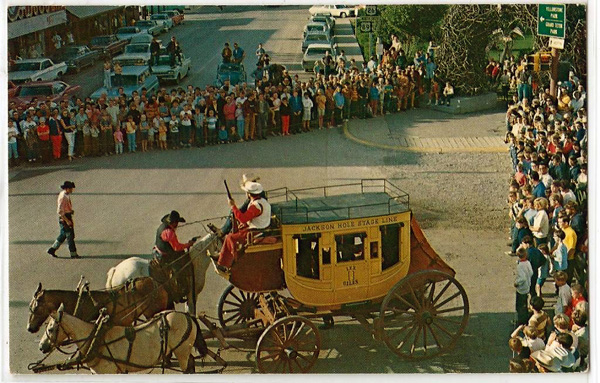
Clover Sturlin robbing the stage, late 1960's, Cache and Broadway.
Different coaches were used at times for the show.
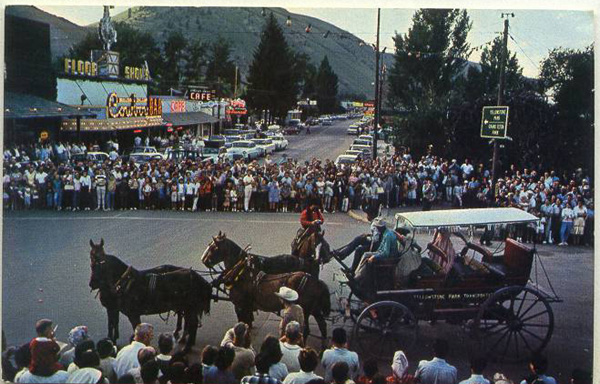
Clover Sturlin robbing the stage, Cache and Broadway.
The damsels riding as passengers were provided by the Pink Garter. The Pink Garter's successor the Jackson Hole Playhouse is still a sponsor of the shootout.
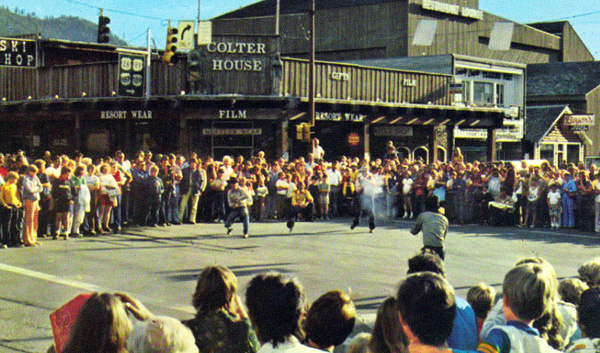
Shootout Corner of Cache and Broadway.
The intersection of Cache and Broadway for years was marked by
the gas station and Richards Ford on the northwest corner. The changes to Jackson are perhaps illustrated by the intersection. Both are Richard's and the gas
station gone now as are the buildings and
business which replaced them.
Indeed, in the immediate area surrounding the
Town Square there are only about six building which are recognizable from prior to World War II,
The Clubhouse, The Jackson Drug Store, The Teton Movie Theater, the Cowboy Bar, the old Frontier Saloon (now Boyer's Inidan Arts) and the Wort Hotel.
In the above photo, Boyers' at 30 W. Broadway, is the third building in. It belongs to Skipppy Boyer, the daughter of John Wort.
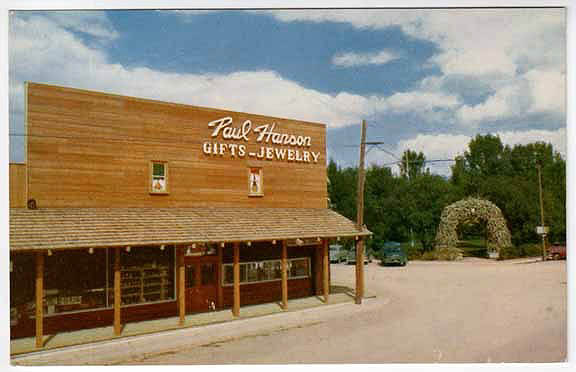
Paul Hanson's approx. 1953, northwest corner of Cache and Broadway.
The back of the postcard recites that the store is "housed in a part of the authentic frontier village block."
The arch in the background was used for the denouement of the show when the posse would attempt to hang Clover from the arch. Somehow he always managed to
escape. The rope would break, he would be rescued, etc.
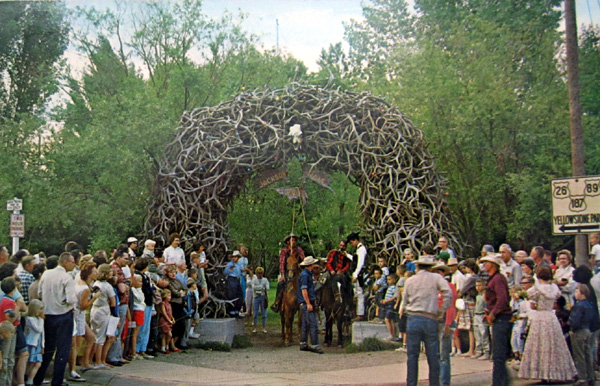
Attempted hanging of Clover the Killer at Arch on corner of
Cache and Broadway.
Because of the impact on traffic on Boadway and Cache, the shootout has been moved to the northeast corner of the Square, the corner of
Deloney and Center. More on the shootout on the next page.
Paul Hanson arrived in Jackson after World War II from Seattle, Washington.
In addition to the gift and jewelry store, he also operated the Coulter House across the street on the
southwest corner of Cache and Broadway. In those days, money was made by the local merchants only in a few brief months in the
summer. Hanson fell into hard times in the
1980's and ultimately lost the businesses.
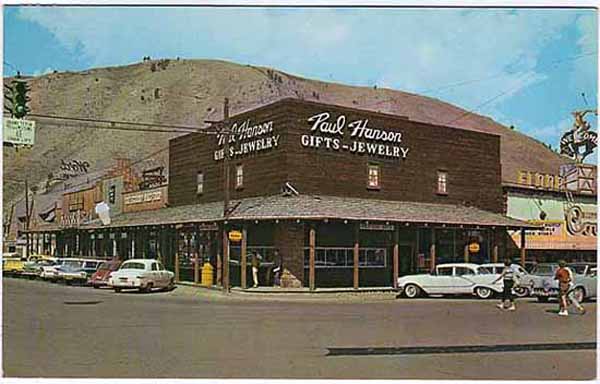
Paul Hanson's approx. 1959.
Paul Hanson contracted encephalitis and died in 2000. His son, also named Paul, contracted multiple sclerosis and died on Feb 20, 2010.
The building has been redone and as of 2013 houses the Jackson Trading Company.
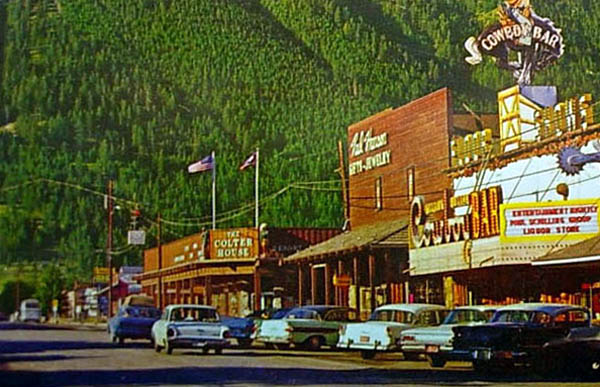
Colter House, southwest corner of Cache and Broadway.
And just as the Coulter House replaced the gas station, the Colter House has been replaced as of 2013 by
"The Shirt off My Back."
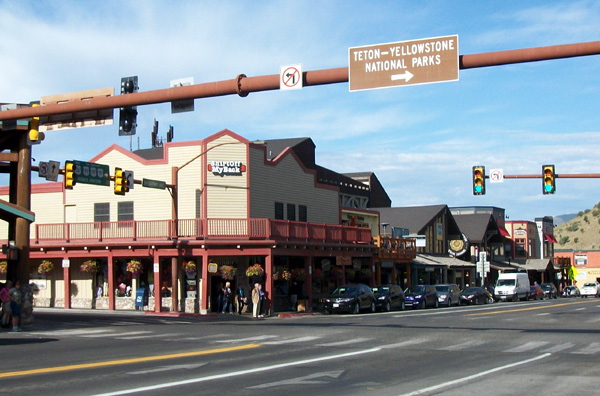
Southwest corner of Broadway and Cache, 2013. Photo by Geoff Dobson.
The changes in the intersection are reflective of all of the changes in Jackson beginning in the 1960's.
In those days many of the local vehicles consisted of pickup trucks
and International Scouts. Ranching
was still an important part of the economy. As of this writing (August 2013) the pickup trucks are no
longer rusty and have four doors. Growth and development has, however, changed the
base of economy, and by 2001 one of the last working ranches in the
area, the Porter Trust property, was proposed for development. This, along with
the Rafter J annexation provoked
a furious debate before the Town Council. Arguments relating to
"urban sprawl" and "big box" stores were made to the Council.
Raye C. Ringholz in her 1992 book, Little Town Blues, Gibbs-Smith Publishing,
Layton, UT, wrote of the effect of the "gentrification" of Jackson. She noted that Lumley's, see
photo previous page,
had been replaced by Albertson's, and small individually owned cafes were
replaced by upscale restaurants:
"The people who migrated to Jackson for its wild scenery, outdoor recreation
and frontier flavor started clamoring for paved roads, airport expansion,
and increased cultural facilities. Instead of fitting into frontier life
themselves, they tried to impose upon their new home the gentrification of
the places they had left. Polarization of the community resulted."
The big growth in Jackson started in the 1970's and has, in
fact, created Ms Ringholz's "polarization" as evidenced by the
debate over the Porter Trust annexation and the "Rafter J" annexation. In March of 2002, the
writer was discussing the growth of Teton County with a horse breaker who grew up in the
Sunshine Basin, southwest of Powell. His attitude was indicated by his observation that Teton County and
adjacent Lincoln County to the south, were "no longer Wyoming."
In a lawsuit, see Board of
County Commissioners of Teton County v. Crow, 2003 Wy 40, 65 P. 3d 720 (2003), the issue came
centerfold. That action dealt with the construction of a house containing some 11,000 square feet
of habitable space. Bill Collins, the county planning director, observed that the county had studied the problem.
At the time of the study the average house was only 1,342 square feet and the very largest
ranch complex was 6,988 square feet. Traditionally, homes in the valley were one-story ranch houses. But by the
early 1990's, Mr. Collins continued, much larger two-story residential "edifices" began appearing.
Most of the new houses were, according to the Comprehensive Plan, second homes "ranging from 5 to 12 times the
size of most normal housing in the valley." The impact, according to Collins, caused an
"upward spiral in land prices, unaffordable to most County residents; that a a result, residents have been
displaced outside the community." This in turn, changed the County's social
structure:
Social and economic classes that once mingled in the community are growing
apart as households that cannot afford homes in Teton County are relocating to
Teton Valley, Idaho, Alpine, and Bondurant.
Indeed, to some extent Mr. Crow, the owner of the 11,000 square foot home, in a way, confirmed that the
community was growing apart. Justice Hill of the Wyoming Supreme Court noted:
Crow's argument goes like this: Some "permanent residents" stereotyped newcomers to
Teton County as "wealthy/affluent non-residents" who were causing land
values to skyrocket. Furthermore, Crow characterizes Teton County's efforts to
channel and control development as discrimination and exhibiting an "animus" for
"wealthy non-residents." Crow also contents that the LDR's [Land Development Regulations] are
founded by a belief in the minds of "permanent residents" that the
"very affluent" or those "with extensive families" have no part in
Teton County's "community fabric."
Mr. Crow certainly did not take "No" for an answer. His case visited the Wyoming Supreme Court two more times, the last appearing at
2007 Wy 177, 170 P. 3d 117 (Wyo (2007) where the Supreme Court upheld a District Court judgment indicated that in light of
$714,000 in accumulated fines Mr. Crow did not have to tear the offending extensions to his house down. The court held that
the determination of the District Court was within its discretion.
Music this page: "Little Joe the Wrangler" used as the tune for "Clover the Killer," courtesy Horse Creek Cowboy
Next Page: Jackson continued, The Shootout Continued, the Square.
|